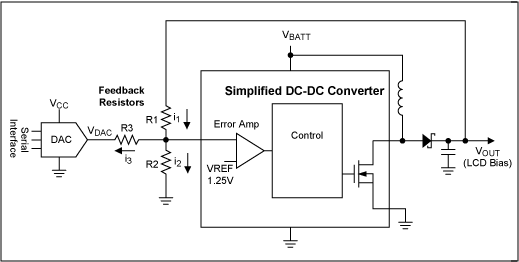Thank you very much for all the comments and answers. I unfortunately did not have time to answer them up to now.
So I start with the first comment and go through until the last one.
Dear TonyM, Yes it’s correct, I unfortunately do not have a circuit diagram, I would like to have one but I think I won’t get it. But that’s “fine” from my question point of view: I wanted to know which methods are “available” -- not that I implement e.g. MOSFETS but I didn’t think of a current DAC for instance.
Dear Tony Stewart EE75, I measured that I can set the output voltage between 3V and 15V and that’s fine for me. The datasheet writes something about switch voltage 60 or 65V, I do not care about this and therefore I even do not know exactly. Why you need this “input” to make an advice related to my question?
Dear Justme, I am not looking that you advise me in how to remove the trimpot. I was asking for concepts (methods) to solve my above question. E.g. an answer from “user1850479” is, to not remove the trimpot and nevertheless the job gets done (over an added current DAC).
Dear GodJihyo, as said, I am afraid to create a ground-loop, but yes that’s a possible idea.
Dear again Tony Stewart EE75, I think you mean something as “user1850479” suggested? That’s certainly a good idea which I really did not think of (over a DAC). However, I am not sure if you exactly meant the same, because you speak about “injecting an offset VOLTAGE”. If I understand you correctly I think this method will not work, because if the 10k poti is set to zero or to max, and I force a voltage over a DAC to this poti, one of those 2 guys will win. Or you mean this “using a calculated R to Vfb”, but then again, it’s a current, not a voltage which I force.
Dear Fred Cailloux, Your guess is wrong. I measured the PCB and the trimpot is connected with one side to the +OUT (so the POSITIVE output). To ground, a small fixed SMD resistor with 430 Ohms is connected. I also measured, that the 2 grounds ( -IN and -OUT ) are also connected together. As you can see from the backside of the PCB, 2 terminals of the trimpot are connected together. Anyway, as already said, I am afraid to create a ground loop if the output voltage selection is only done via MOSFETs. Basically I like the idea with optocouplers best (as already indicated inside my question) because I do not create a current loop and because the trimpot is “high-side-related” (to + Vout) , I don’t need to care about some things with the galvanically isolated optocoupler. But the problem with these devices is the high on-state resistance. Those I have searched have some 100 Ohms at least, which is too much. I would need an additional circuit/MOSFETs etc. Maybe there are ones available with lower Ron ?? Your other idea, just take the on-state-resistance of a FET directly as a poti and control the gate by a uC via a RC-RC low-pass-filter is not a good idea, if I have understood you correctly, because everything is strongly dependent on temperature. I prefer designs which are dependent on a ratio rather than designs depending on an absolute value.
Dear mkeith, A nice idea basically, which I also thought of, but, I unfortunately did not mention, this is 1st too slow and 2nd too big (at least as big as with relays).
Dear user1850479 and hacktastical, Thank you very much to both of you for showing the nice concept of introducing a current DAC! I am afraid of creating any ground loops with introducing a DAC but obviously, it is a common praxis which I was not aware of -- and therefore I would like to thank you! What I especially like is, that I can let the poti as it is and if the uC is not alive, the circuit will still be working as before. So, as this seems also a possible practical solution (since even Maxim presents this in an own paper), I now think that also just using some MOSFETs where I switch in- and out the suitable resistors could also practically be a good solution (I was afraid that I create a too large ground loop when using ANY not galvanically isolated device). To use the current DAC concept I would have to solder out the SMD resistor with 430 Ohms (and replace it with a higher ohmic one) since the DS4432 can handle at most 200 uA, but I think that will be no issue.
Again, thanks a lot for all the answers and I will think about all the options and decide which one will be best for me!


